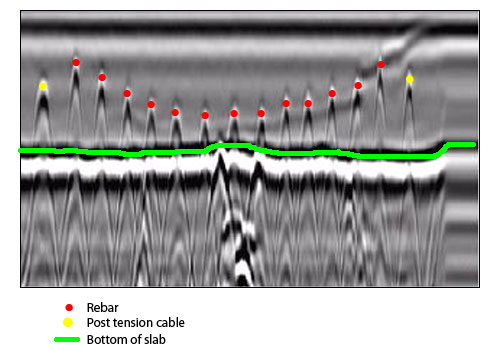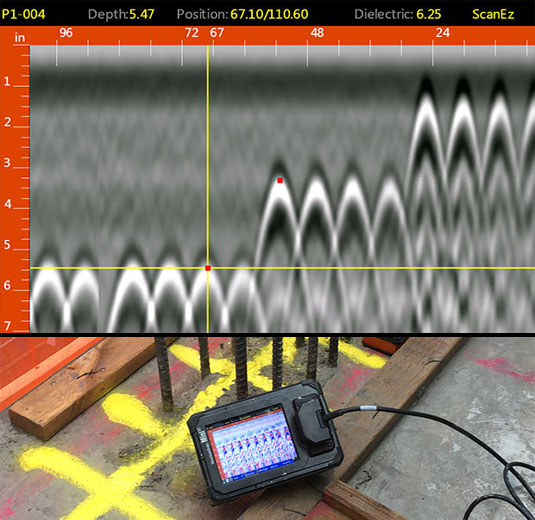Discover Hidden Obstacles with RainierGPR Concrete Scanning Modern Technology
Discover Hidden Obstacles with RainierGPR Concrete Scanning Modern Technology
Blog Article
Exploring the Key Advantages of Concrete Scanning in Building And Construction Projects
In the world of modern-day building and construction methods, the use of concrete scanning innovation has actually become an essential tool for making sure task performance and architectural honesty. From enhancing safety steps to precisely identifying energies concealed beneath the surface area, the benefits of concrete scanning are diverse. The capability to enhance task timelines and reduce costs while protecting existing structures is a testament to the worth this technology offers the construction market. As we delve right into the nuanced advantages of concrete scanning, it becomes apparent that its impact prolongs much past surface-level analyses, using a look into the elaborate internet of advantages waiting to be uncovered.
Improved Precaution
Utilizing advanced concrete scanning innovation improves safety and security measures on construction sites by giving exact detection of prospective threats hidden below the surface. This modern technology enables building groups to recognize rebar, conduits, post-tension cables, and other blockages prior to excavation or exploration, significantly decreasing the risk of accidents. By pinpointing these elements precisely, workers can avoid damaging vital structural components, thus preventing injuries, delays, and costly repairs.
Furthermore, concrete scanning plays an important function in making sure the honesty of existing frameworks throughout developments or improvements. By identifying weak points, spaces, or wear and tear within concrete elements, designers can resolve these problems proactively, improving the overall safety and long life of the structure. This positive method not only alleviates the danger of structural failures yet likewise reduces the potential for crashes triggered by unforeseen structural shortages.
Fundamentally, the application of concrete scanning innovation works as a positive precaution that safeguards both construction workers and the structural honesty of buildings, ultimately contributing to the overall success and effectiveness of building and construction tasks. - RainierGPR Concrete Scanning
Accurate Discovery of Energies
Concrete scanning technology facilitates accurate recognition of underground energies, improving building site safety and effectiveness. Precise detection of utilities is critical in building projects to stop expensive damages, task delays, and most importantly, make certain the safety of employees and the public. By using sophisticated scanning technologies such as ground-penetrating radar (GPR) and electromagnetic induction, construction teams can draw up the area of buried pipelines, cable televisions, and various other energies with high levels of precision.

Time and Expense Efficiency

Concrete scanning modern technology allows building groups to accurately find rebar, post-tension cables, and other ingrained things within concrete structures. This specific information helps in staying clear of costly errors such as accidental damage to essential components during boring, cutting, or coring tasks. Additionally, by determining possible hazards in advance, the demand for pricey repairs or remodel as a result of problems can be minimized, causing set you back financial savings for the task.

Additionally, the capacity to swiftly and accurately discover energies underneath the surface area without creating any kind of damages not just conserves time yet also prevents expensive interruptions to existing facilities. Generally, the moment and price performance advantages of concrete scanning make it an important tool for improving building job administration and execution.
Preservation of Structural Integrity
Preserving the structural integrity of buildings and infrastructure is paramount in ensuring long-term stability and safety. Concrete scanning plays an important function in this conservation process by allowing construction professionals to identify possible hazards to the architectural honesty of a structure or facilities before they intensify right into significant concerns. With the usage of sophisticated scanning modern technologies such as ground-penetrating radar (GPR) and electro-magnetic induction, building and construction groups can non-invasively analyze the problem of concrete frameworks, situate rebar, post-tension wires, and various other embedded elements, and identify any kind of gaps, fractures, or wear and tear within the concrete.
Improved Project Planning
In order to ensure the effective implementation of building projects, careful interest to detail and websites extensive planning are vital components that originate from a detailed understanding of the architectural conditions recognized with concrete scanning. Improved task planning, promoted by concrete scanning, enables construction groups to preemptively address prospective challenges, designate resources more effectively, and establish practical timelines. By precisely recognizing the place of rebar, post-tension cables, and various other ingrained objects within concrete frameworks, project supervisors can create much more precise building and construction strategies that reduce the danger of pricey errors or delays. Furthermore, the information obtained from concrete scanning makes it possible for stakeholders to make enlightened decisions pertaining to structural alterations, restorations, or growths, resulting in smoother task changes and enhanced overall job results. Inevitably, including concrete scanning right into the project planning phase enhances sychronisation among employee, cultivates aggressive analytic, and adds to the successful delivery of construction projects within budget and routine restrictions.
Conclusion
In final thought, concrete scanning uses various advantages in building and construction tasks. By improving precaution, precisely discovering utilities, boosting time and expense efficiency, preserving architectural stability, and aiding in project preparation, concrete scanning verifies to be an essential device for effective job execution. Its capacity to minimize dangers, enhance performance, and make sure job integrity makes it an important asset for building professionals.
In the realm of modern building practices, the application of concrete scanning innovation has emerged as a crucial tool for ensuring task effectiveness and architectural stability.Concrete scanning technology allows construction groups to accurately find rebar, post-tension cables, and other ingrained objects within concrete frameworks. Via the use of sophisticated scanning technologies such as ground-penetrating radar (GPR) and electromagnetic induction, building groups can non-invasively assess the condition of concrete frameworks, situate rebar, post-tension cable televisions, and various other embedded elements, and determine any Read Full Article type of gaps, cracks, or wear and tear within the concrete.
In order to make sure the successful implementation of construction projects, careful focus to detail and detailed preparation are important elements that stem from a detailed understanding of the architectural problems recognized via concrete scanning. Inevitably, including concrete scanning right into the task preparation stage boosts control amongst group participants, cultivates aggressive analytic, and adds to the successful shipment of building jobs within budget plan and routine constraints.
Report this page